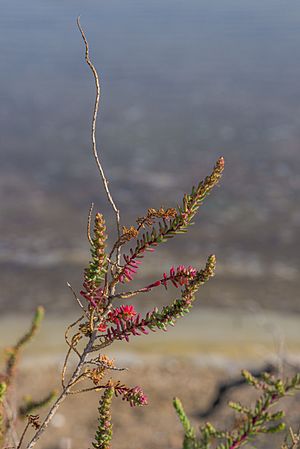Shrubby sea-blite facts for kids
Quick facts for kids Shrubby sea-blite |
|
|---|---|
 |
|
| Scientific classification | |
| Genus: |
Suaeda
|
| Species: |
vera
|
Suaeda vera, also called shrubby sea-blite, is a special plant that loves salty places! It's a type of flowering plant in the Amaranthaceae family. This small shrub can look a bit different depending on where it grows. You'll often find it in very dry, salty areas like salt flats and salt marshes. Plants that can live in salty environments are called halophytes.
Contents
Plant Names Can Be Tricky
Giving plants their scientific names can sometimes be confusing! The famous scientist Carl Linnaeus first described this plant in 1753. He called it Chenopodium fruticosum.
Later, another scientist named Peter Forsskål studied plants in places like Egypt and Yemen. He found a plant he called Suaeda vera. It turned out that Forsskål's S. vera was the same plant Linnaeus had already named! This kind of mix-up happens sometimes when different scientists are working.
Over the years, different botanists (plant scientists) have used different names for this plant. For example, in Britain, some scientists used to call it S. fruticosa, but then changed it back to S. vera. In other places, like Iraq and Israel, scientists might use S. fruticosa or S. vermiculata for similar plants, which adds to the confusion. It's like having different nicknames for the same friend, or the same nickname for different friends!
What Does Suaeda vera Look Like?
This plant is a small shrub. It has a special number of chromosomes, which are like tiny instruction manuals inside its cells. For Suaeda vera, this number is 2n=36.
Where Does Suaeda vera Grow?
You can mostly find Suaeda vera along the coasts of the Mediterranean Sea. In Europe, it grows northwards along the Atlantic coasts of Spain, Portugal, France, and even into south-eastern England.
Because of the naming confusion, knowing its exact range in Africa is a bit harder. It grows in the Canary Islands and the northern African countries like Maghreb. It might also grow in countries further south, but it's not always clear if those plants are S. vera or a similar species. In Asia, it's found around the Mediterranean area, but it doesn't usually grow further east into places like Iraq or Pakistan.
How Suaeda vera Lives in Salty Places
Suaeda vera is a true salt-lover! Its seeds grow better in fresh water than in salty water, which is interesting. In places like Britain, you'll often see it where shingle (small stones) meets the salt marsh. This plant is very good at living in tough, salty conditions where most other plants can't survive.
Uses of Suaeda vera
For a long time, Suaeda vera and other similar plants were used to make something called 'barilla'. Barilla was important because it was used to create soda ash. Soda ash was a key ingredient for making soap and glass! In the 1700s and 1800s, large amounts of these plants were sent from North Africa to other countries for this purpose.
Today, scientists are looking into new ways to use Suaeda vera. For example, in Tunisia, people have tried growing it using seawater for irrigation. This could be a way to grow crops in dry, salty areas. However, because the plant naturally has a lot of salt, it might be better used as part of animal feed, mixed with other plants, rather than as the only food source for animals.
See also
 In Spanish: Suaeda vera para niños
In Spanish: Suaeda vera para niños

